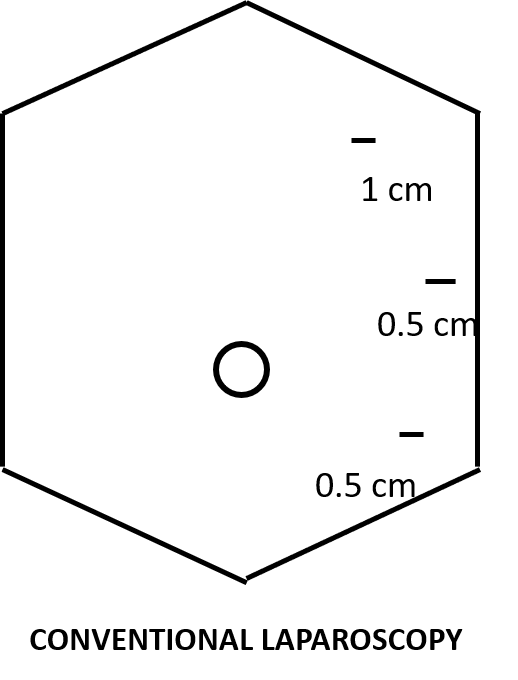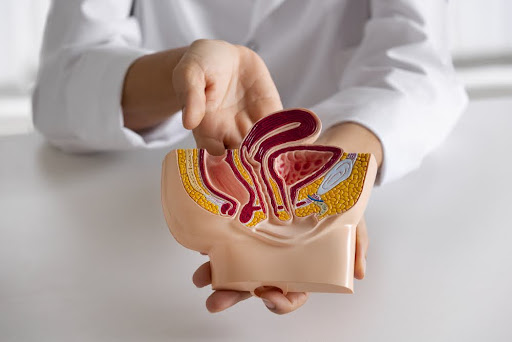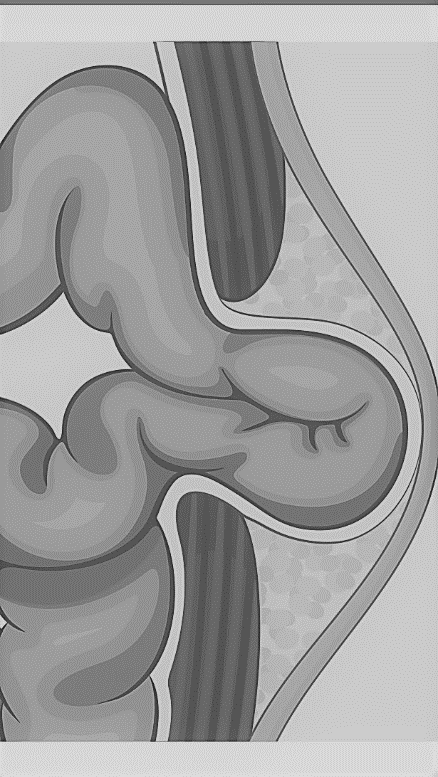
Umbilical Hernia Surgery in Mumbai
- Home
- Umbilical Hernia Surgery in Mumbai
Umbilical Hernia Surgery in Mumbai
A hernia is an abnormal protrusion of a part or whole of viscus through an internal opening in the wall of the cavity that contains it. Umbilical hernias constitute about 8.5% to 9% of all hernias. Any kind of hernia is usually caused either due to a weakness in the abdominal muscles or increased abdominal pressure which forces the content through the normal abdominal musculature.
Conditions that cause increase in intra-abdominal pressure are:
Chronic cough
- Bladder neck obstruction or stricture urethera
- Enlarged prostrate
- Lifting heavy weights
- Repeated pregnancy
- Constipation
- Vomiting
Irrespective of the site hernias can be:
- Reducible- when a hernia reduces itself on lying down or can be reduced easily by the patient himself or the surgeon.
- Irreducible- when the contents hernia cannot be returned back to the abdomen it is called as irreducible hernia.
- Obstructed or incarcerated hernia- when a hernia is irreducible along with features of intestinal obstruction due to occlusion of the lumen of the bowel.
- Strangulated hernia- a hernia is said to be strangulated when the blood supply of its contents is seriously impaired. This usually develops when the neck of the sac is seriously impaired.
Umbilical hernia in infants and children
This usually happens through a weak umbilical scar due to sepsis in the neonatal period. This kind of hernia is more common in male babies than females. 90% of these close spontaneously. Surgery is warranted only if they fail to close by 18 months of age.
Para-umbilical hernia of adults
In adults the hernia does not protrude through the umbilical cicatrix. It protrudes either through the linea alba just above the navel or just below it. Hence it is called as para-umbilical hernia.
In most cases the contents of the hernia are formed by omental fat. In some cases it is accompanied by small intestines and rarely by large intestines.
- Para-umbilical hernias are more common in women who are affected 5 times more than men.
- Obesity is one of the major pre-disposing factors
- Most patients are above 40 years of age.
- Repeated pregnancies are the other pre-disposing factor.
Signs and symptoms
- Pain
- Swelling in the region of the navel
- Most of the times the lump is hard as it consists of omentum
- It may be reducible and cough impulse may be present.
laparoscopic umbilical hernia repair surgery in Mumbai, India: The Treatment

Laparoscopic umbilical hernia surgery is a surgical procedure used to repair umbilical hernias. In laparoscopic umbilical hernia surgery in Mumbai and elsewhere, the abdomen is usually entered using an optical trocar at the Palmar’s point. Remaining trocars are inserted through the incisions shown in the figure. Surgeon then inserts a small tube with a camera on its end known as a laparoscope. The laparoscope assists the surgeon in viewing the hernia on a TV monitor. The surgeon typically looks into a TV monitor and operates.
During laparoscopic umbilical hernia repair surgery in Mumbai and elsewhere, first the hernial contents are visualized. These can be omentum or intestines depending on the patient. These are gently reduced with the help of graspers. After this the hernial defect is closed with non-absorbable sutures and an adequate sized dual mesh is placed around the defect and fixed with sutures and tackers. Hemostasis is checked and carbon dioxide removed. Ports are closed and sutured.
Indications of laparoscopic umbilical hernia surgery in India and elsewhere
Laparoscopic umbilical hernia repair surgery in India and elsewhere should be performed because of the high risk of further complications. Indications for adult umbilical hernia repair surgery in mumbai in adults include pain, skin ulceration, incarceration, hernia rupture, strangulation and defects exceeding 1 cm.
Advantages of laparoscopic umbilical hernia surgery in mumbai technique
- Less pain and post-operative discomfort
- Patients are able to walk around after a few hours of surgery.
- Early discharge from the hospital. Most patients go home on the next day after surgery.
- Laparoscopic technique is advantageous in obese patients.
- Laparoscopy provides a much more magnified view of the operating field and hence better visualization
- Early return to work. Patients are able to get back to work much earlier.
Side effects or complications of the umbilical hernia surgery procedure
Common complications of laparoscopic umbilical hernia repair surgery include:
- Pain
- Infection
- Possible reoccurrence of the hernia
- Adhesion
- Obstruction of the small or large intestines
- Bleeding
- Mesh shrinkage or compression and mesh migration are other possible adverse complications which can happen after laparoscopic umbilical hernia repair.
laparoscopic umbilical hernia surgery in mumbai: Post-operative care
After laparoscopic umbilical hernia repair surgery in india, the patient is transferred to a postanesthesia care unit. The nursing team closely monitors the patient until he or she is stable. The amount of time spend in the postanesthesia care unit depends on the type of anesthesia used and the patient’s progress. If a patient is given general anesthesia, he or she must be awake and coherent before leaving the postanesthesia care unit.
While in the postanesthesia care unit, the patient is given ice chips, and if they are tolerated, the patient can also be given water after 6 hours. IV lines stay in place until the patient is able to take or tolerate clear liquids and this mostly occurs immediately after the surgery and if a general anesthesia was used.
Mostly, patients are discharged on the next day.
Laparoscopic Umbilical hernia repair surgery FAQs (Frequently Asked Questions)
Laparoscopic umbilical hernia surgery cost in Mumbai, India
Generally, umbilical hernia repair surgery cost in mumbai, india is determined by different factors. Some of the factors which determine the umbilical hernia surgery cost in mumbai include type of the hospital and type of room. Laparoscopic umbilical hernia repair surgery cost also depends on the duration of hospital stay and the type of mesh used. Adult umbilical hernia repair surgery cost is usually covered by insurance.
Laparoscopic umbilical hernia surgery in Mumbai is performed by Dr. Aparna Govil Bhasker at the following hospitals:
- Gleneagles Global Hospital, Parel, Mumbai, India
- Saifee Hospital, Charni Road, Mumbai, India
- The Esthetic Clinics, Kandivali East, Mumbai, India
- Namaha Hospital, Kandivali West, Mumbai, India
- Suchak Hospital, Malad East, Mumbai, India
- Apollo Spectra Hospital, Tardeo and Chembur, Mumbai, India
- Apollo Hospital, CBD Belapur, Navi Mumbai, India
- MGM Hospital, Vashi, Navi Mumbai, India
- Currae Specialty Hospital, Thane, India
- Sunshine Global Hospital, Surat, India
Contact details
Mobile: +919819566618/ +919930922761
Email: info@bestbariatricsurgeon.org
Website: www.bestbariatricsurgeon.org , www.aparnagovilbhasker.com
Facebook: https://www.facebook.com/draparnagovilbhasker/
Linked in: https://www.linkedin.com/in/dr-aparna-govil-bhasker-82836b34/
About Dr. Aparna Govil Bhasker
Dr. Aparna Govil Bhasker is an accomplished Bariatric Surgeon and Laparoscopic GI Surgeon. Extremely passionate about her field of specialization. She completed her MBBS and MS in General Surgery in 2006, from Mahatma Gandhi Institute of Medical Sciences (MGIMS), Sewagram. Set up in 1967 by none other than the first health minister of India, Ms. Sushila Nayar, MGIMS is deeply rooted in Gandhian ethics. Read more


Surgeon in India


Bariatric Surgery: Pros and Cons

Types of Hernias and Their Treatment Options Explained
- Intra-Gastric Balloon Insertion Surgery
- Laparoscopic Adjustable Gastric Banding Surgery
- Gastric Sleeve Surgery / Laparoscopic Sleeve Gastrectomy
- Single Incision Sleeve Gastrectomy Surgery
- Laparoscopic Roux-en Y Gastric Bypass Surgery
- Laparoscopic Banded Roux-en Y Gastric Bypass Surgery
- Laparoscopic Mini Gastric Bypass Surgery /Omega Loop Bypass
- Laparoscopic Sleeve Gastrectomy with Duodeno-Jejunostomy Surgery
- Laparoscopic Duodenal Switch Surgery
- Laparoscopic Sleeve Gastrectomy with Duodenal Ileostomy (SADI) Surgery
- Laparoscopic Revisional/Redo Bariatric Surgery
- Metabolic Surgery for Diabetes
- Terms & Conditions
- Privacy Policy
- Sitemap

